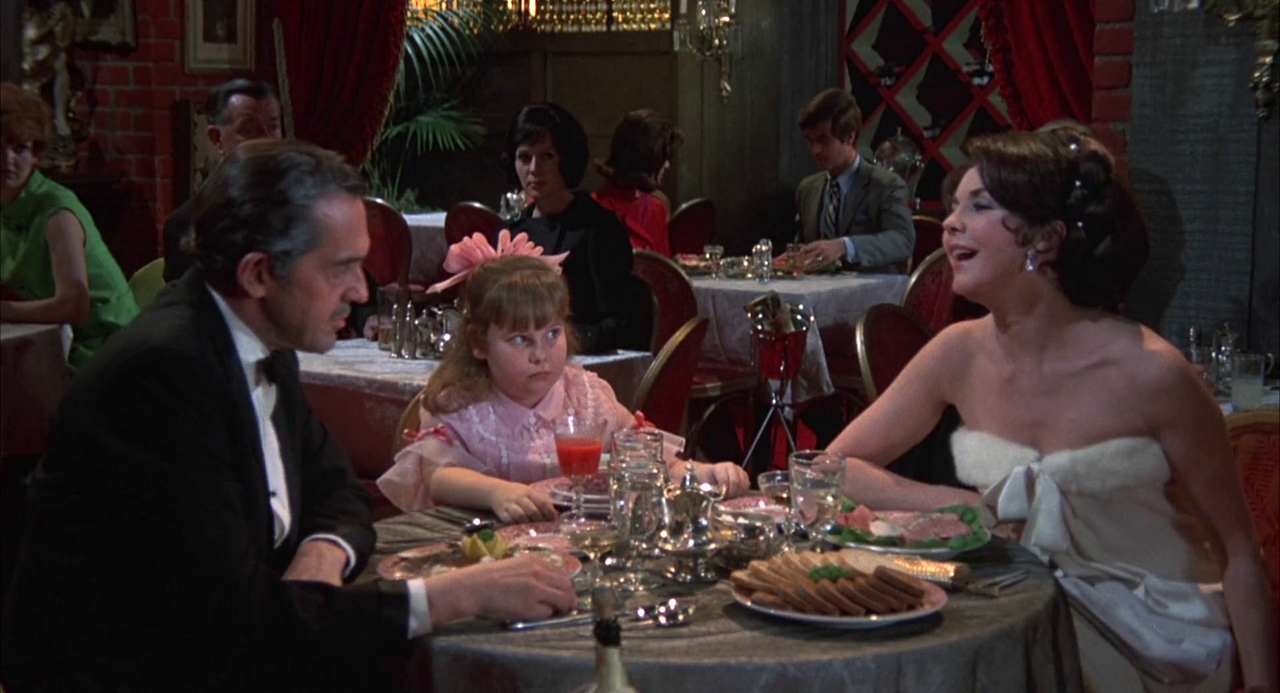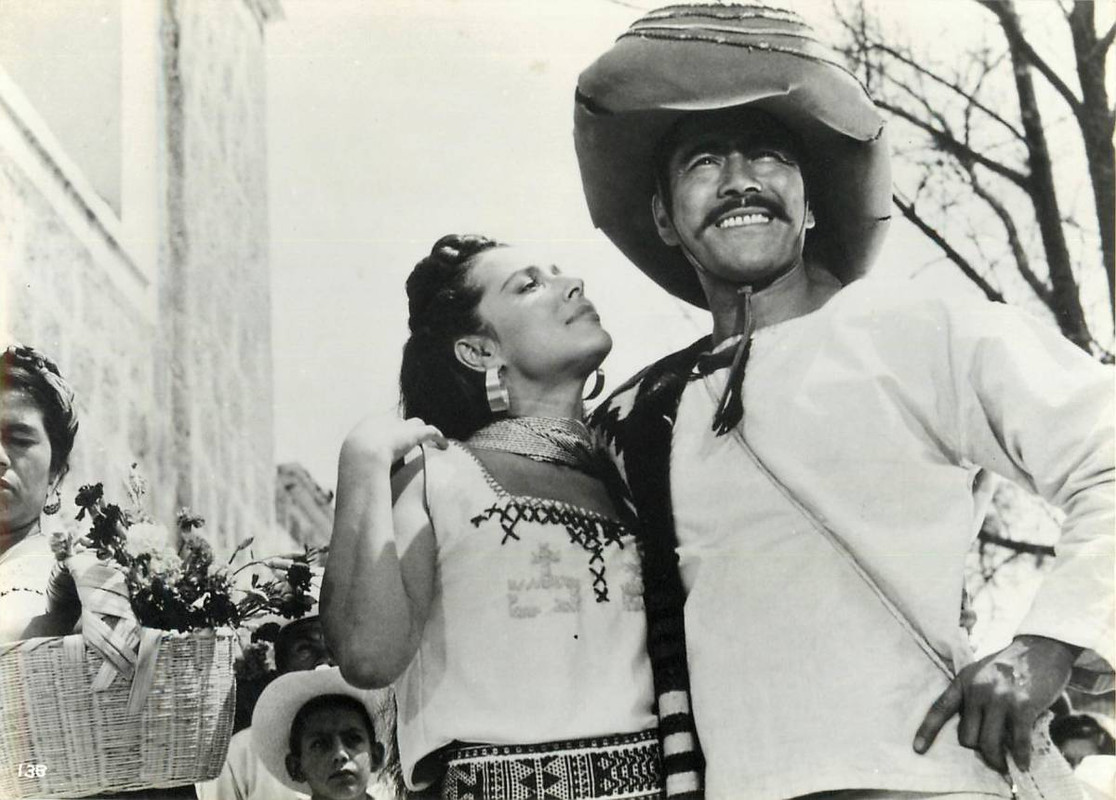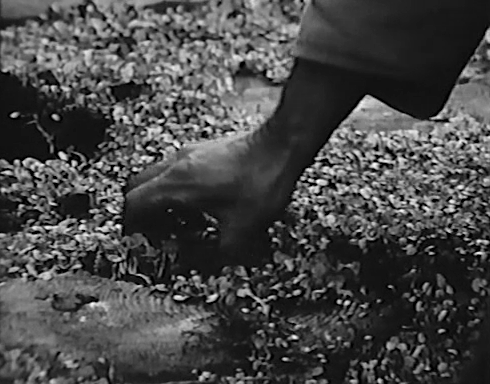“We'll go back to Nice tomorrow. The Bay of Angels brings us luck.”La baie des anges [Bay of Angels] (Jacques Demy, 1963)
Dec
23
pears

A blonde Moreau at a restaurant table with a man seen from the back. There are several semi-empty wine glasses and pears sliced lengthwise on a plate, covered with a napkin. Jeanne's character Jackie Demaistre is holding a small sheet of paper with a schematic drawing of a roulette wheel while throwing the man a sceptical glance. DP: Jean Rabier.
– Jean Fournier
1960s
“We say hip, hooray,
Hip, hip hooray,
For fat!”Angel, Angel, Down We Go [Cult of the Damned (Robert Thom, 1969)
Dec
22

A chubby, piggy pink-dressed debutante (Joan Calhoun) flanked by her uppity-class parents (Charles Aidman and Jennifer Jones) in a fancy restaurant. The kid gives her mother the side eye. Other eaters look on in shock. DP: John F. Warren.
– Barry Mann & Cynthia Weil, The Fat Song
“The first section's dead. There's no one left. We lost contact with the second. The third is reorganizing. All that's left is the fourth. It's enough to start over with.”La battaglia di Algeri [The Battle of Algiers] (Gillo Pontecorvo, 1966)
Dec
18
Arabic Language Day

Petit Omar (Mohamed Ben Kassen) reading out a letter to Ali La Pointe (Brahim Hadjadj) in the قصبة, (Cashbah). If it were not for the leads' jeans and sneakers, this scene could be in any century. DP: Marcello Gatti.
Speak an Arabic language on UN Arabic Language Day
少年 [Shōnen / Boy] (Nagisa Ōshima, 1969)
Dec
17
Freebie: National Insurance Awareness Day

The boy waiting next to a buzy road. DPs: Seizō Sengen & Yasuhiro Yoshioka.
Freebie: National Insurance Awareness Day (USA) redux.
A boy (Bin Amatsu), helps out his father and stepmother's insurance money scam by pretending to be injured in traffic.
Ánimas Trujano (El hombre importante) [The Important Man] (Ismael Rodríguez, 1961)
Dec
16
Underdog Day

Now very important Ánimas Trujano [Toshirō Mifune] holding his Juana (Columba Domínguez). DP: Gabriel Figueroa.
An underdog for National Underdog Day (USA)
Underdog Ánimas Trujano is dead set on becoming his town's next mayordomio, the wealthy, respected man in charge of funding one of Oaxaca's major religious festivals. He does find a way, a terrible one, and does get the respect and riches he wishes for. But even with all the money and praise in the world, Ánimas' continuous down his well-trodden path of gambling away the riches bestowed, and cheating on his long-suffering wife.
It took me a moment to get comfortable with the casting of Japanese movie legend Toshirō Mifune as the titular important man (also see Noé Murayama in Rodríguez's Los hermanos Del Hierro from 1961, but from that moment on, Ánimas Trujano feels as universal as any great cinematic experience should be.
“Come Senators, Congressmen,
Please heed the call,
Don't stand in the doorway,
Don't block up the hall”Crisis: Behind a Presidential Commitment (Robert Drew, 1963)
Dec
14
Alabama Day

Bobby on the phone, seen from the back. DP: Gregory Shuker.
Alabama Day: filmed in Alabama.
In what he dubbed “Stand in the Schoolhouse Door”, George Wallace, Alabama governor, blocked Black students from walking into the University so he could uphold his inaugural promise of “segregation now, segregation tomorrow, segregation forever”. This prompted a national crisis, resulting in the President issuing Executive Order 11111, making the #NationalGuard step in.
– Bob Dylan, The Times They Are a-Changin (1964)
In a then-groundbreaking new documentary format, Robert Drew and associates followed President John F. Kennedy and Attorney General Robert F. Kennedy during the crisis. And they filmed everything; from tense phone calls, private discussions, private moments (one of RFK's daughters on the phone with a bemused “Kerry”, Dept. Nicholas Katzenbach), and many, many shots in which nothing – which is everything – is said.
Holubice [The White Dove] (František Vláčil, 1960)
Dec
9
Official Lost And Found Day

Michal (Karel Smyczek) finds the white dove perched on a sculpture. The artwork depicts a faceless boy. DP: Jan Čuřík.
Something is lost and found on Official Lost and Found Day (USA)
“We come to life, we die… It's a perpetual renewal. How boring.”剣 (小説) [Ken / The Sword] (Kenji Misumi, 1964)
Dec
6
rice

Young people eating. An older woman in kimono scoops rice from an electric rice cooker. When read from right to left, this scene – as are numerous others in Chikashi Makiura's photographed 剣 (小説) – are split into tradition and modernity. DP: Chikashi Makiura.
– Mibu
Mr. Hayashi (Bruce Baillie, 1963)
Dec
5
World Soil Day

Mr. Hayashi's hand digging in soil.
Someone digs in soil on World Soil Day
